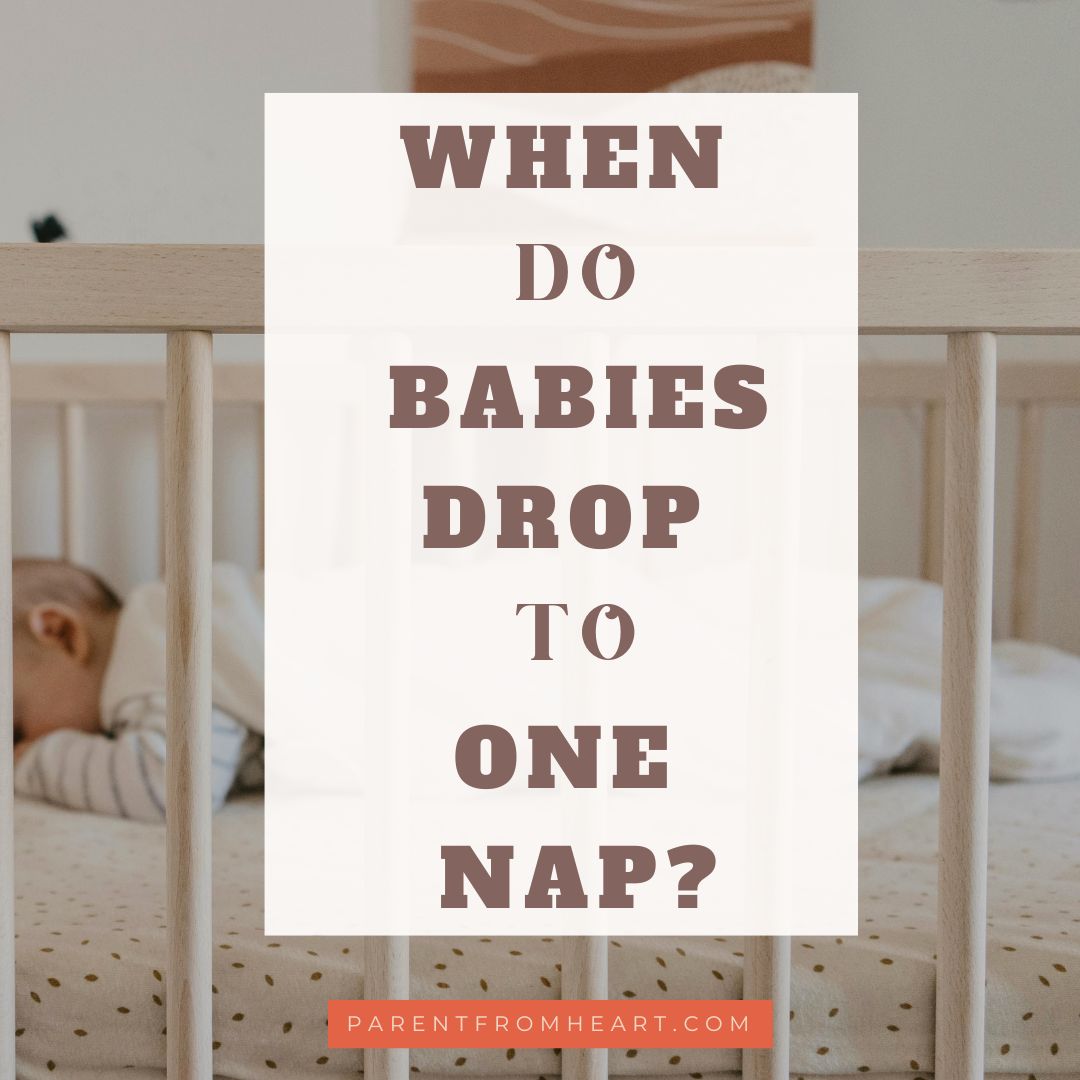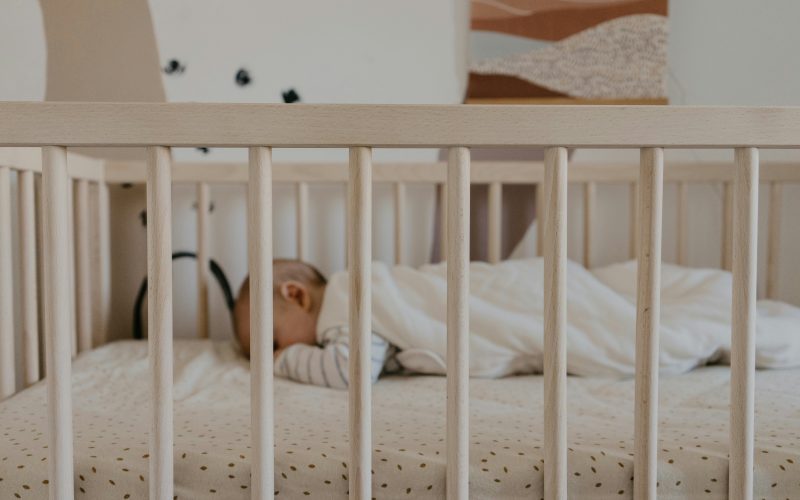Table of Contents
Remember the newborn days when your baby slept most of the day, and you could actually get things done? Well, as they grow older, their sleep patterns also change. One major shift I experienced with my three boys was when they went from multiple naps to only one in a day.
What is a “One Nap”?
One nap refers to babies sleeping only once during the day instead of many daytime slumbers. This typically happens between 18 and 24 months old.1 However, other tots can experience it as early as 12 months; some take longer to transition.
It’s a huge jump from when they were infants. From one to four napping times a day, it goes down to one. It’s a transition because it can take some time for babies to get used to and adjust their sleep schedule accordingly.
Interestingly, most three-year-olds still have a nap every day. Even at four, around 60% of them are still catching some daytime Z’s.2 But once they hit five, less than 30% are napping. And by seven, fewer than 10% are nodding off during the day.

When Do Babies Switch To One Nap?
Like most things with babies, there isn’t an exact age or set timeline for when babies drop down to one nap. Every child is unique and may experience this shift at different ages.
My firstborn was around 14 to 15 months old when his napping schedule changed. From his usual two-hour morning snooze and a shorter afternoon siesta, he started taking one longer nap in the middle of the day.
So, keep a look out for your little one’s patterns and needs. Their transition to one nap depends on their:
- Growth spurts
- Teething
- Developmental milestones
- Daily routine
What are the Signs Baby is Ready to Drop to One Nap?
Our tots typically show signs when they’re ready to make the switch. Here are some signs to look out for:
Longer Wake Times
As our youngsters grow and develop, their wake times will also increase. A perfect example of this manifestation is longer play or exploration times during the day. If you notice your little one spending more hours doing so without getting restless or fussy, it may be a sign that they’re ready for one nap.
Shorter and Inconsistent Naps
If your child’s usual nodding-off time gets shorter and shorter, they may be ready to transition their sleep schedule. This could mean their body clock is adjusting, and they no longer need as much daytime sleep to be active and explore.
Resisting Daytime Snooze
Just like my second-born, some babies may start resisting their second nap. Or, they may only take 10—to 15 minutes before waking up. This is another indication that their body clock is changing. Since they sleep well at night, they can go without the catnap during the day.
Trouble Falling Asleep at Night
Another tell-tale sign is struggling to fall asleep at their usual bedtime. Too much daytime nod-off can disrupt their natural sleep pattern and make it challenging to settle down at night.

9 Tips for Making a Smooth Transition to One Nap
Once you’ve noticed the signs and determined that your child is ready to drop their second nap, here are some tips to help with the switch:
1. Slowly Adjust Wake Times
New routines take time. So, gradually increase wake times between their morning and afternoon naps, slowly easing them into staying awake for longer periods. You can slowly push back the second daytime shut-eye by 15 minutes each day until it merges with the first.
2. Eliminate Screen Time Before Bed
Spending too much time in front of a screen can keep your tot stimulated. If this happens, they might not fall asleep easily. Therefore, you can limit or cut their screen time at least an hour before bedtime. This way, they can wind down and get ready for a snooze.
3. Provide A Quiet and Calm Environment Conducive to Sleep
A space with minimal light and noise helps encourage your child to settle down. It sets a mood for slumber and helps them relax and fall asleep faster. You can play music or white noise to help them drift off more quickly—another solid technique I used with my youngest during the transition.
4. Find the Right Timing
Observe your child’s natural energy levels and determine the best time of day for their one nap. Some babies may do well with an early afternoon nodding off, while others prefer a late-morning snooze. So, pay attention to what works best for your little one.
5. Make Naptime Longer
When switching to one nap, make sure that the remaining shut-eye is long enough to give enough rest. Aim for a minimum of 1.5 hours and up to 3 hours if possible. This will help bridge the gap until bedtime and ensure your baby gets enough rest to make it through the day.
6. Keep a Consistent Bedtime Routine
Maintaining a consistent bedtime routine is the key to adjusting to one nap. Doing so signals that it’s time for sleep and settling down. Stick to calming activities like reading, singing, or cuddling before bed. This is my tried-and-tested trick for getting my kids ready for bedtime.
7. Keep Them Busy
Keeping your baby occupied and engaged during awake time can help prevent overtiredness before naptime. This is a fool-proof technique for all of my playful boys. Depending on their age, you can engage them in activities like coloring, playing tag, playing with toys, and singing.
8. Be Patient
Any kind of transition can be tough, especially for children. As such, be patient and understanding with yourself and your bub. Feel free if you need to take a break or ask for help. Either way, with consistency and patience, your child will eventually adapt to their new one nap schedule.
9. Seek Help If Necessary
A visit to your doctor can help if your little one is having a hard time switching. Talk to your pediatrician or consult a sleep specialist for advice and support. They can provide helpful tips and strategies to address any sleep difficulties your child may be experiencing.
What are the Benefits of One Nap?
Healthy sleep habits are crucial for your child’s growth and development. By transitioning to one nap, you can provide them with longer and more restful sleep, leading to many benefits, including:
- Improved mood and behavior
- Better cognitive learning and functioning
- Increased energy levels
- Strengthened memory
- Enhanced immune system
Moreover, having one solid nap during the day allows your child to be more alert and engaged during their awake time. This is wonderful because it gives them better learning opportunities and bonding experiences with you.
Impact of External Factors on One Nap Schedule
Of course, our bub’s one nap schedule may not always go as planned. These external factors can disrupt their daily routine and make it challenging for them to nod off at the designated time:
- Teething or illness
- Vacation or travel
- Changes in the environment (e.g., moving, new daycare)
- Daylight savings time
- Parents returning to work
These elements can cause trouble falling asleep, shorter naps, or earlier wake-up times. Our kids may even temporarily revert to their previous two-nap schedule.
When this happens, stay patient and flexible. Continue to provide a consistent sleep schedule since they will likely return to their one-nap routine once things settle down.

Common Questions About One Nap Schedule
What time should the one nap be?
The best time for a one-nap schedule is typically around midday, between 1 pm and 3 pm. This siesta time is perfect for kids since it’s roughly in the middle of their awake time.
How long does the transition to one nap usually take?
Transitioning to a one-nap schedule can take anywhere from 2 to 6 weeks. It may be a gradual process as your child adjusts to the new schedule and learns how to fall asleep during this new time.
How long should the one nap be?
Ideally, a one-nap should be at least an hour to two hours long.5 But if they wake up earlier or later than expected, try adjusting their bedtime accordingly so they get enough rest.
Is it okay if my child falls asleep before nap time?
Yes, it’s perfectly fine for your bub to fall asleep a bit earlier than the designated one-nap time. Just make sure you follow their cues and put them down for their nap as soon as they show signs of tiredness.
What if my child seems tired before or after the one nap?
It’s normal for our little ones to have periods of drowsiness throughout the day. However, if they seem overly tired or fussy before or after their one nap, it may be a sign that they need an extra nap. In this case, you can try giving them a shorter or earlier second nap and see if it helps.
What if my child is not ready for a one-nap schedule?
Every child is different and may transition to a one-nap schedule at a different age. If your little one seems resistant or unable to handle the longer awake time, it’s okay to stick with two nod-offs longer. Trust your instincts and adjust accordingly.
Conclusion
Transitioning to one nap is another milestone in your child’s development. While you may encounter challenges when implementing this new schedule, stay patient and flexible. Follow these tips and stay consistent for you and your little one.
What’s your one-nap experience? Share it with us in the comments below!
Like this post? Click on the image below to pin it for later!

Sources
- Summer, J. “When Should Kids Stop Napping?.” Sleep Foundation, 2024.
- Weissbluth, M. “Naps in children: 6 Months– 7 Years.” OUP Academic, 1995.
- McCarthy, C. “Naps: Make the most of them and know when to stop them.” Harvard Health Publishing, 2021.
- Wein, H. (Ed.). “Naps Can Aid Learning in Preschoolers.” National Institutes of Health, 2017.
- “Infant and toddler health.” Mayo Clinic, 2022.











